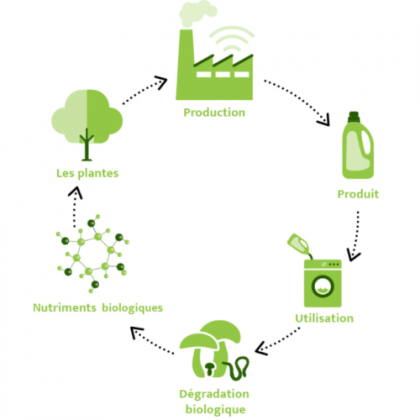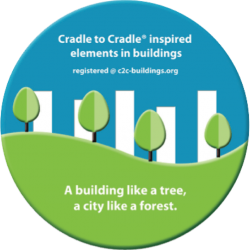Cradle to Cradle
The cradle of the circular economy
What is Cradle-to-Cradle®?
The Cradle to Cradle® approach defines and promotes the development of upcyclable products, which means that, unlike conventional recycling, it maintains the quality of raw materials throughout the multiple life cycles of the product and its components.
It is a philosophy of eco-design and circular economy that suggests that the human species and its activities are not a problem for nature or health, and that it is possible to “do good” by aiming for a positive impact, rather than just “do less harm” by reducing its impacts.
It is therefore about having a positive footprint on health and the environment by drawing inspiration from the natural model according to four main principles:
- Everything is a resource (the notion of waste does not exist),
- Renewable energies must be given priority,
- Diversity should be celebrated,
- It is necessary to have a systemic and collaborative vision.
In the end, this means that everything can be considered a resource and that the notion of waste disappears: the right materials enter into infinite cycles/metabolisms, used in the right place at the right time. This is how its founders gave it its name, translating into French the expression “from the cradle to the cradle”.
"Do good rather than less bad".
In contrast to the decreasing approach, which aims to reduce the negative impact of Man on the environment, the Cradle to Cradle® approach aims to increase its positive impact.
It is therefore a positive approach that gives context and perspective to life cycle analysis. It is no longer a question of reducing or minimizing our footprint and consumption but of changing direction, gradually transforming our system from within. It is therefore not a question of managing degrowth but of managing a new form of growth that integrates, from the outset, the interests of future generations.
Cradle to Cradle® (C2C) is therefore the engine of the circular economy and allows for continuous flows in open and closed loops, while creating value at each step of the process. To carry out this eco-design, it is essential to think upstream of the product so that its design brings, in the long run, benefits on the economy, the social and health/well-being, but also on the environment.
Originally, the C2C approach applied to products. It thinks differently about their sustainability and therefore plans differently for their design, the materials used and their flows. In order to decarbonize the industry and preserve resources, the manufacturer foresees, from the design stage, different scenarios that will allow the regeneration of the used product, if possible indefinitely, via 2 cycles :
The biological cycle

In a biological cycle, materials are broken down by microorganisms to form new nutrients. Biodegradable products are transformed into compost, thus constituting a base of nutrients that can be used by new natural resources.
All products that belong to this cycle are called “consumer products”. In the C2C vision, clothing, shoes or any other product that wears out with use – such as tires – should be designed with the earth in mind. The diagram above, which presents the example of the manufacture of a biodegradable bioplastic bottle, gives an illustration.
Usually, what we call “recycling” is more like “under-cycling” because it often destroys value (e.g. energy recovery or landfill).
Here, the cycle is closed and has a positive impact because the bottle was eco-designed from 100% biodegradable components and can therefore return to the soil from which it was derived (e.g. starch from corn stalks) to be used as compost.
The technical cycle
A technical cycle consists of controlled flows of industrial materials. The idea is to allow mass-produced industrial products to circulate in a closed circuit, while maintaining a constant level of quality. The fact that the system is closed is a prerequisite to create optimal value, but also to allow for the temporary use of toxic substances when unavoidable (before finding substitutes).
Ease of disassembly and care in choosing materials for a product are fundamental to the design. The products and materials in this cycle are called “use products”.
The diagram above presents the example of a television set, produced by assembling elements of defined quality and which can be reused to recreate the same material (closed loop) or participate in the manufacture of other products (open loop).
The technical loop also makes the principle of functionality economy possible. This is, for example, the case of laundromats where consumers prefer not to buy the washing machines and to pay for their use. In this approach the equipment remains the property of the manufacturer, and is returned to him after a defined period of use. One of the advantages of this system is that it is in the manufacturer’s interest to use materials of a higher level and quality, as well as a dismountable system, to easily recover components of which he will have thought, during the eco-design, the following uses within economically resilient ecosystems.
The fields of application of Cradle to Cradle® are
Product level
Cradle to Cradle® productcertification
Cradle to Cradle® (C2C) certification is the international benchmark for the circular economy. It is awarded by the C2CPII (C2C Product Innovation Institute) on the basis of evaluation reports produced by accredited organizations, such as Upcyclea, the only French company to be accredited.
The certification verifies the 5 C2C criteria: non-toxicity, circularity, renewable energy, respect of water and respect of social rules. The list of C2C products is available on www.c2ccertified.org.
Different levels of certificates (Basic, Bronze, Silver, Gold, Platinum) allow to progressively move towards an optimal version of the product.
Before you embark on the full certification process, you also have the option to conduct a C2C certification pre-audit. This will allow you to assess the strengths of your company and the actions to be implemented.

Building level
C2C-inspired building referencing
The “C2C-inspired Building” referencing is an audit conducted by the Hamburg Environmental Institute (HUI) on the “C2C-Inspired Elements” and “C2C Delights” aspects of the building. They represent respectively the material functions with positive impacts (e.g. air or water purification, “material bank” construction principle, C2C products) and the immaterial functions with positive impacts (e.g. aesthetics, luminosity, bio-waste management) of the building.
Upcyclea produces the eligibility file, supervises the process and assists the HUI during the final audit to verify compliance with the file.
If the audit is successful, then the “C2C-Inspired” referencing is pronounced; the MOA receives a diploma and its building is published on www.C2C-Buildings.net.
